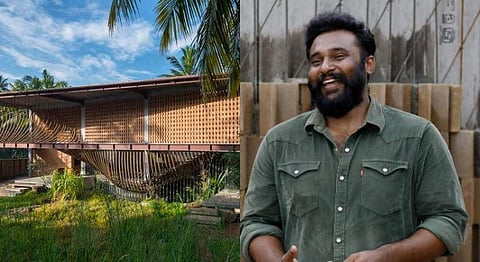
- #HGCREATORS
- #HGEXPLORE
- #HGVOICES
- #HGSHOP
- CAREERS
- ABOUT US
- CONTACT US

Conversations around sustainability have become much more frequent than before, given that the consequences of its absence have been increasingly visible in the past few years. ‘Sustainability’, however, is an umbrella term that houses various aspects. One of its facets that deserve some more acknowledgement is sustainable architecture and housing.
Vinu Daniel, one of India’s finest architects is at the fore of propagating the idea of sustainable architecture. His work and projects follow the basic tenets of sustainable architecture — reduce the negative impact on the environment through moderation and efficient use of materials. Vinu takes the latter to heart and uses natural and discarded materials to design and build structures that nothing short of absolutely brilliant.
In 2007, right after wrapping up his work with Auroville Earth Institute for the UNDP (United Nations Development Programme) Post-Tsunami construction, Vinu set up Wallmakers – a sustainable architecture and building collective. They believe in using mud and waste to their maximum potential to create spaces that are functional and enticing. This ideology is fuelled by the fact that historical indigenous settlements throughout, right from the Indus Valley Civilisation, were all made of closely available natural materials and had near-zero production of new materials.
“While the work and construction of a building results in the production of a lot of scrap, we are not deterred by this demon. Instead, we have learnt to build with it,” believes team Wallmakers.
The IHA, a residence in Mannanthala in Kerala, is one of their outstanding projects. Just the exterior of the structure is something not many would expect, and the interior goes even beyond that. The low-lying site was giving way to environmental-imbalance, and so, their primary concern was to find a way to circumvent this issue.
Another awe-worthy construction is a residence in Pathanamthitta, where the debris from the previous building was smartly integrated into the primary focus of this one. In this building, half-cut coconut shells and discarded metre-box cases seamlessly mingle with the rest of the edifice, whilst contributing to functionality. It is the textbook definition of the kind of house you would never want to leave.
Vinu’s sensibly-built, minimal-scrap-generating spaces closely reflect the inspiration he derives from late architect Laurie Baker’s impeccable work. Integrating nature with something that is most likely to be a predator of nature, is not an easy task. However, this is something that Vinu and his team at Wallmakers strive to do in every project of theirs. Again, to allow human establishments to be set up in ways that do not disrupt the ecological balance, in more ways than one may be a heavy task, but is definitely the need of the hour. Reclaiming the mud that has been dug for the structure as a building material, letting the nuances of the surrounding nature enter the building, and finding the beauty in so-called ‘scrap’, are all ‘must-haves’ on the sustainable architecture list, an Vinu’s work checks all the boxes.
Earning merit from India Today, NDTV, International Sustainability Awards, HUDCO Design Awards, and so many more definitely validates Vinu’s work. However, more than any of his accolades, we firmly believe that his actions reflecting sustainable thinking and inclusive development are his true laurels.
You can check out their work here.
If you enjoyed reading this, we suggest you read:
